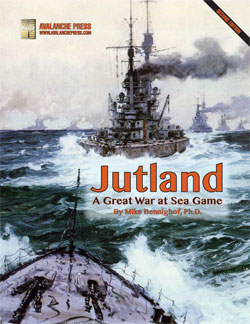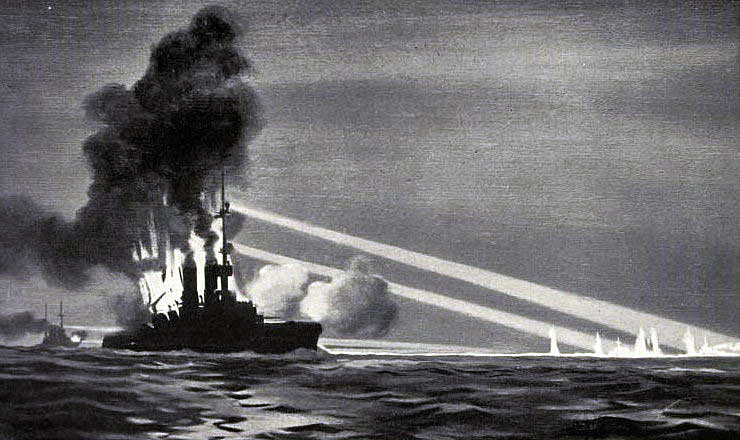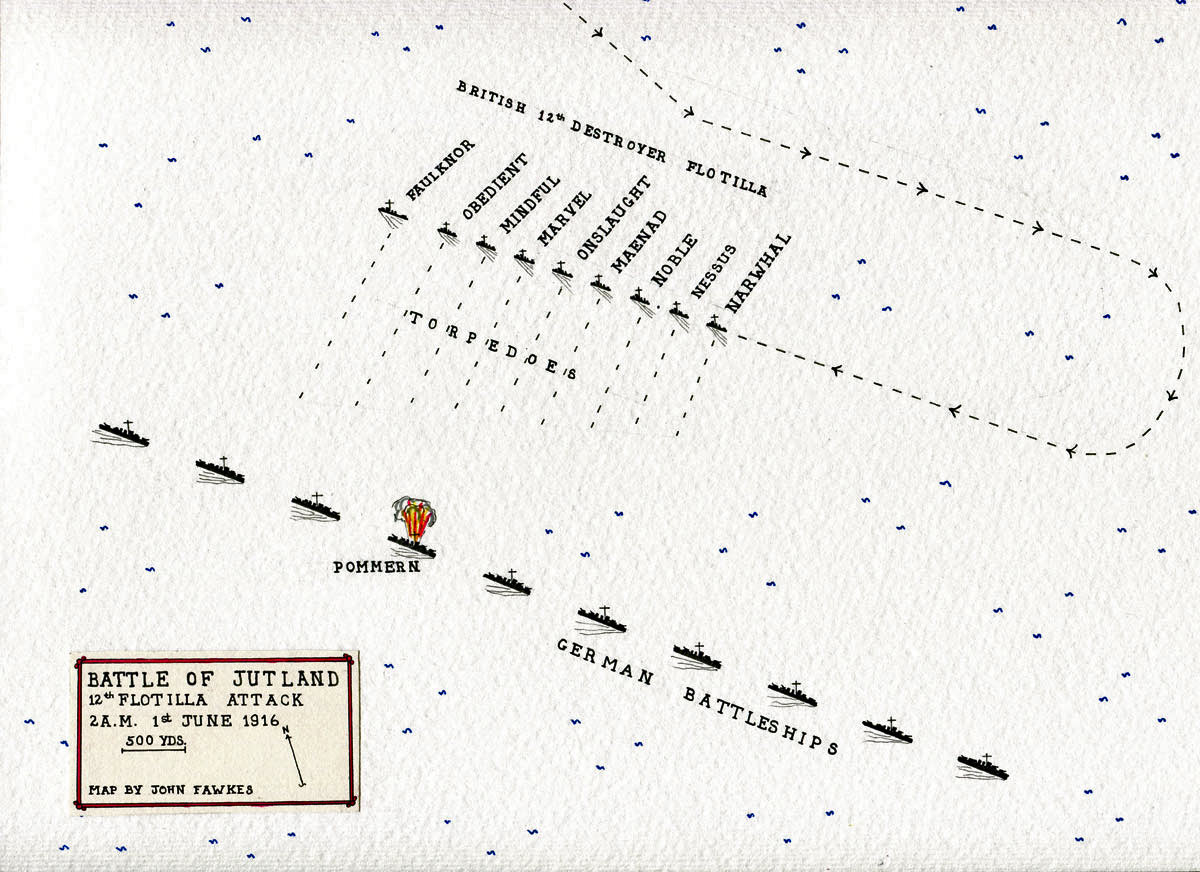| Jutland:
The Battle, Part Six:
Night Falls on the North Sea
By Mike Bennighof, Ph.D.
June 2024
 As night approached on the North Sea, Reinhard Scheer commanding the German High Seas Fleet knew that his opposite number, Grand Fleet commander Sir John Jellicoe, would try to prevent his return to the fleet base at Wilhelmshaven to the south of the battle area. The Germans had done well so far, but the British retained a significant edge in combat power both in terms of heavy guns and torpedoes. The apparent narrow German victory could easily turn into a crushing defeat. As night approached on the North Sea, Reinhard Scheer commanding the German High Seas Fleet knew that his opposite number, Grand Fleet commander Sir John Jellicoe, would try to prevent his return to the fleet base at Wilhelmshaven to the south of the battle area. The Germans had done well so far, but the British retained a significant edge in combat power both in terms of heavy guns and torpedoes. The apparent narrow German victory could easily turn into a crushing defeat.
Scheer ordered his fleet to turn first south-west and then south, arranging his squadrons to put his dreadnoughts between the British and his one squadron of fantastically vulnerable pre-dreadnoughts. The battle cruisers would shield the left flank of the High Seas Fleet with the fleet’s light forces outside of them; Scheer appears to have been unaware that two of the remaining four had suffered dramatic drops in their top speed.
The British remained deployed into a single, lengthy line of battle, with the back end continuing to fire at German torpedo boats. Jellicoe mistook the sound of the guns for a continued engagement with the German dreadnoughts, and believed that his fleet still had contact with Scheer’s, even as the Germans moved away. Scheer had turned at 2027, and not until 2040 did Jellicoe realize that he longer had contact with the enemy. Sir David Beatty, commanding the battle cruisers, continued to give few position reports, and when he did, they often lacked important details like the enemy’s heading.
Shortly after 2100, German and British light cruisers resumed their vicious close-quarters engagement, and at 2118 Beatty’s battle cruisers sighted their German counterparts, opening fire a few minutes later. The fast battleships of Fifth Battle Squadron had left Beatty to assume their positions at the tail end of Jellicoe’s battle line, but Beatty had picked up the two surviving ships of Third Battle Cruiser Squadron, giving him a total of six heavy ships to the Germans’ four. All of the latter had suffered heavy damage and resulting reductions in their firepower.

The British 2nd Light Cruiser Squadron in the Jutland night action.
The German battle cruisers had slowed to allow their commander, Franz Hipper, to transfer from the torpedo boat G39 (which had taken him from his stricken flagship Lützow) to Moltke. The British fire stopped Hipper from boarding, leaving Capt. Johannes Hartog of Derfflinger in command. Seydlitz suffered five more hits from heavy shells and Derfflinger one. Unable to return fire effectively thanks to falling visibility and their own damage, the German battle cruisers veered away to the west, behind the oncoming II Battle Squadron of six pre-dreadnoughts. With night coming on, lookouts aboard the obsolete ships could see even less than those of the battle cruisers, and fired only 23 shells between them. The British battle cruisers, on the other hand, could spot the Germans and hit both Schleswig-Holstein and Pommern. Rear Admiral Franz Mauve, commanding the pre-dreadnoughts, ordered them to load torpedoes, apparently intending to make a low-speed, suicidal torpedo run against Beatty’s battle cruisers. Sanity quickly took hold and he ordered his ships to turn to starboard instead, away from the enemy, and unload their torpedoes.
Jellicoe continued to have little idea where the enemy lay; not until 2159 did Beatty see fit to report the sightings of German battle cruisers and pre-dreadnoughts to his superior. Jellicoe responded by ordering his fleet to turn south at 2201, thereby looking to renew the battle at first light rather than force a night action. At this point he did not yet know that Beatty had lost two battle cruisers, though he was well aware of the Grand Fleet’s massive superiority over the High Seas Fleet.
“A night battle between heavy ships,” he wrote later, “with so many destroyers and torpedo boats present would largely be a matter of chance . . . only disaster could result.”
The light cruisers Caroline and Royalist spotted the German battle line at 2208 and each launched a torpedo; one passed just ahead of the German dreadnought Nassau and the other apparently passed under her. The commander of the nearby British 2nd Battle Squadron, Vice Admiral Sir Martyn Jerram, warned the cruisers that the heavy ships they had spotted were likely Beatty’s British battle cruisers.
Beatty would socially shun Jerram after the battle, claiming that Jerram should have brought his dreadnoughts to support the battle cruisers. But Jerram doesn’t appear to have known Beatty’s exact position, either, and proceeded cautiously amid the lack of solid information and his orders from Jellicoe to head southward and avoid an engagement in the now-full darkness.
On the German side, Scheer also prepared to renew the battle in the morning, when he assumed that the British would seek a battle near Horn Reef, off the Danish coast just north of the then-German border. Not knowing how many of his torpedo boats still possessed torpedoes (no destroyers or torpedo boats at the battle carried more than a single set of reloads for their tubes, if that many), but understanding that after running hard for hours most of the coal-fired boats would throw off sparks if called on for high speed, Scheer chose not to order a massed nighttime torpedo attack. Instead, the flotillas would make for Horn Reef and attack the British battleships there at dawn.
The battle cruisers Moltke and Seydlitz now led the High Seas Fleet; Hipper’s other two heavy ships could only make 18 knots. Derfflinger had suffered battle damage that slowed her, while von der Tann, like some of the smaller ships, suffered from clinkers (unburned slag) in her boilers – the stokers had not been able to clear them away under the demands to pour on more coal during the battle, and the blackened lumps displaced fresh coal, drastically lowering boiler efficiency. The two lagging battle cruisers went to the very end of the German line, behind Mauve’s pre-dreadnoughts.
Jellicoe formed the Grand Fleet’s battleships into three columns, and ordered his destroyer flotillas to take up station five miles behind the battleships to avoid their mistaking British ships for Germans and torpedoing them. Beatty and his six remaining battle cruisers, now joined by the four armored cruisers of the Second Cruiser Squadron, steamed along the same course several miles to the south-west of the battle fleet, on the opposite side of the High Seas Fleet.

SMS Pommern is torpedoed.
The Germans had only three swept paths through the thick minefields in the Helgoland Bight, the bay leading to the German naval base at Wilhelmshaven. One of these was only used to depart from the German coast – the exit into the open sea had no markers. One lay along the Dutch coast, the other along the Danish coast, then proceeding through coastal waters to the north German ports. Most of Jellicoe’s staff believed that Scheer would take the Danish route, as it was much shorter, but Jellicoe insisted that the Germans would take the long way home since the British would be in a less favorable position to cut them off.
Instead, Scheer took the short cut, steaming to the south-east across the wake of the Grand Fleet. At 2341 the Admiralty sent Jellicoe a radio intercept indicating Scheer’s course, but the Grand Fleet commander ignored it – this made the third time that the high command had sent him such intelligence, and the first two had been utterly wrong. The Grand Fleet continued on its course. Meanwhile, the Admiralty’s signals intelligence operation picked up Scheer’s request for zeppelin reconnaissance over Horn Reef at first light, but decided not to pass this game-changing information on to Jellicoe.
A series of skirmishes began at 2250, between the light forces of the two fleets. The Germans, better trained at night-fighting than their British counterparts, got the best of most of these clashes – but when the British struck, they did so with devastating results. A torpedo from the British light cruiser Southampton sank the German cruiser Frauenlob with the loss of all but nine of her crew.
Several times, British battleships sighted German battle cruisers, but none of them opened fire. The British 4th Destroyer Flotilla acted with far more aggression, but the Germans showed their night-fighting skills as the dreadnought Westfalen destroyed the flotilla leader Tipperary with a hail of shells and sank the destroyer Fortune.
Just around midnight, the light cruiser Elbing attempted to avoid British torpedoes by slipping between the dreadnoughts Posen and Nassau. Posen rammed the cruiser, flooding her engine rooms. By 0200 it became obvious that the ship, while not sinking, could not be saved. A small salvage crew tried to save the ship anyway, but when British destroyers approached, they scuttled the cruiser and escaped in the ship’s cutter.

SMS Thüringen devastates HMS Black Prince at point-blank range.
Shortly after 0100 on 1 June, the German dreadnought Thüringen spotted the British armored cruiser Black Prince at a range of just 1,100 yards and poured 51 shells into her – not a single round missed. Three more German battleships joined in, blasting the cruiser to pieces. She sank with all 857 of her crew. The destroyer Ardent, seeking her flotilla, followed the sound and smoke to the site and received the same treatment; the 4th Destroyer Flotilla had been put out of action.
The British battleship Malaya spotted a German dreadnought in the glow of the burning Black Prince, but her captain refused to open fire, telling his gunnery officer that the squadron commander must have seen it as well yet had issued no orders to fire. The squadron commander, Rear Admiral Hugh Evan-Thomas, used similar logic regarding a sighting report from Valiant, that Jellicoe was nearby and must already know. As ship after ship spotted the escape of the High Seas Fleet to the east, Jellicoe continued to believe the Germans to be to his west.
By 0200, Lützow’s attempt to reach home had failed, as forward flooding finally lifted her propellors out of the water. The four torpedo boats escorting her came alongside to take off her crew, all but six stokers who remained trapped in the forward diesel-dynamo room. They still had a telephone connection to the bridge and Capt. Viktor Harder, the last man off the ship, gave them a tearful farewell. They remained alive as the big ship took a torpedo from one of her escorts, rolled over and sank.
The British 12th Destroyer Flotilla made its attack just after 0300, as German torpedo boats returned from their own unsuccessful attempt to find the Grand Fleet. The German battleships hesitated to open fire, thinking these were their own torpedo craft. Most of the British torpedoes missed their targets, but one or two struck the pre-dreadnought Pommern, which exploded into a massive ball of flame shortly afterwards. She broke in half and sank with all 844 men aboard.

They would be the last casualties of the Battle of Jutland. When dawn came, Scheer’s fleet was within 20 miles of Horn Reef, and they anchored in Jade Bay in time for lunch. As reports came in of three British battle cruisers sunk, the admiral ordered champagne broken out on the bridge of his flagship Friedrich der Grosse.
Jellicoe recalled Beatty’s battle cruisers at 0440, and by noon the Grand Fleet was on its way home. The dreadnought Marlborough went directly to the Humber for repairs to torpedo damage, narrowly avoiding a submarine torpedo that might have finished her. Jellicoe ordered no champagne.
“The bed-rock qualities of the Navy stood unshaken,” the British Naval Staff Appreciation would claim, yet admitting, “but the system of tactics and fleet command did not stand the strain.”
Jellicoe had fumbled the chance for a great naval victory, aided by subordinates who failed to report crucial information at key moments. Scheer handled his fleet far more ably, but as he raised his glass the overall situation in the North Sea remained no different than it had been 24 hours earlier.
The story continues in Part Seven.
Order Jutland second edition here.
The Jutland Experience
Jutland Second Edition (full game)
Jutland: North Sea 1914
Jutland: Dogger Bank
Journal No. 46: Iron Dogs
Retail Price: $209.96
Package Price: $170.00
Gold Club Price: $134.00
You can order the Jutland Experience right here.
Sign up for our newsletter right here. Your info will never be sold or transferred; we'll just use it to update you on new games and new offers.
Mike Bennighof is president of Avalanche Press and holds a doctorate in history from Emory University. A Fulbright Scholar and NASA Journalist in Space finalist, he has published a great many books, games and articles on historical subjects; people are saying that some of them are actually good.
He lives in Birmingham, Alabama with his wife, three children, and his new puppy. His Iron Dog, Leopold, could swim very well.
Want to keep Daily Content free of third-party ads? You can send us some love (and cash) through this link right here.
|
